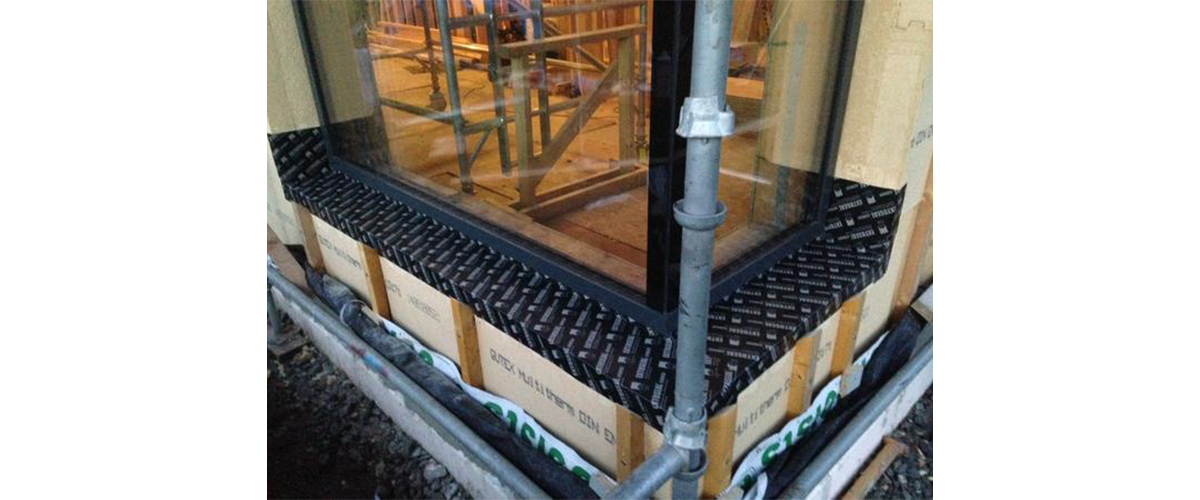Window Flashing That Lasts

At the sill-jamb intersection, window flashing must bridge three dimensions. EXTOSEAL ENCORS remain air and water tight, and solidly bonded to the substrate, even when stretched over these tough corners.
Windows are the weak link in your assembly. Along with doors, they amount to the largest holes in your envelope. To ensure that your building is air- and water-tight, continuity between high-performance windows and your air barrier/WRB is essential. We’ve talked a lot about how to ensure air barrier continuity at windows, but of greater importance in your building hierarchy of need is ensuring that water can’t get into your building. EXTOSEAL ENCORS, because of its flexibility, durability, air- and water-impermeability, and guaranteed lasting performance, is far and away the best choice for fenestration flashing.
Well-executed window flashing that is continuous with your weather-resistant barrier is critical to creating a drainage plane for excess water. Because glass is highly waterproof, rain that hits the window will end up on the sill. For this reason, sills need to have the proper pitch to ensure easy drainage of rainwater. This is especially important for high-performance buildings, in which windows are set deeper into the assembly for the purposes of minimizing thermal bridging and accommodating more insulation. And once water hits the sill, it needs to run off.
EXTOSEAL ENCORS: Long-lasting, airtight, waterproof and flexible

The flexibility of EXTOSEAL ENCORS means you don't have to worry about the integrity of your water-tight flashing pan being compromised at challenging corners and junctures.
EXTOSEAL ENCORS window flashing is a thick, but highly flexible tape with acrylic-modified butyl adhesive that will last for the life of your building. Upon application, EXTOSEAL ENCORS can be folded down over and connected to the WRB, ensuring a continuous air and water barrier from WRB to window. It’s important not to cover the WRB more than about an inch, because EXTOSEAL ENCORS is vapor closed, and you don’t want to diminish the outward drying potential of your vapor-open WRB. And your WRB should definitely be vapor-open! ENCORS can also be taped up into the window frame, ensuring a continuous drainage plane from window to sill to WRB using just a single piece of tape. If the sill is an uneven surface – masonry, for instance – TESCON primer can be used to ensure a seamless, watertight connection.
EXTOSEAL ENCORS is particularly useful because of its flexibility. It can be especially difficult to flash windows at the corner where the sill meets the jamb – a place in which the flashing material has to stretch over three dimensions. Typical peel-and-stick flashing can’t handle this multi-dimensional stretching, so multiple strips have to be used – creating the potential for gaps, which can lead to air and water leakage and damage the sill. Because of their great flexibility and multi-release strips, EXTOSEAL ENCORS performs particularly well at these challenging corners. Your flashing pan should extend 4-6” up the jambs, so flexibility is key to ensuring continuity at these points. And for windows set deeper into the assembly, strips of EXTOSEAL can be layered shingle-style over one another to ensure continuity of the drainage plane from window to sill to WRB.
EXTOSEAL ENCORS technical specs:
- Acrylic modified butyl adhesive (butyl rubber modified with acrylate) is accelerated age-tested to last 100 years
- Tape is self-bonding under the effect of heat
- Application temperature range: 15F to 95F (-1oC to 35C)
- Once bonded, adhesive performs from -4F to 176F (-20C to 80C)
- Feature a highly flexible carrier foil with low restoring forces, allowing it to be stretched over frame corners (eliminates the need for multiple strips and provides further insurance against water ingress)
- Are completely watertight and block dampness
- Bond to wood, hard/high density plastic, metal, concrete, OSB, plywood, fiberboard, and ProClima membranes without a primer; primer recommended for bonding to uneven substrates such as concrete, brick, foamglass, and some OSB.
- Self-seal around screw and nail holes
- Are fully vapor-closed
- Come in widths of 6, 8, and 12" for different window depths (though strips can be layered shingle-style for deep-set windows); all are 20m (65' 7")
- Feature three release strips for easy application over window frames, sills, and down to your WRB/exterior sheathing
- Bonds should not be subjected to tensile strain after application.
Ensuring Air Barrier Continuity Around the Entire Window

Once the EXTOSEAL ENCORS flashing pan has been installed, exterior window components can be overlaid, and you can be confident in your window sill's weather protection.
For the most part, ENCORS is not relied on for airtightness, simply to do its job as robust sill protection. There are many ways to complete your airtight window installation. Our favorite is to use Contega EXO: a vapor open, air-tight, and water-tight tape, ensures that your window frame is continuous with the WRB, further preventing air and water intrusion into the assembly. We recommend pre-taping your window frames before inserting them into the rough opening so that they can be easily attached to your WRB.
With solid acrylic adhesives that are waterproof and become stronger with time, these Pro Clima tapes are the best way to ensure that these challenging connections will remain robust and water tight for the life of your building. So for difficult intrusions like windows, make sure to choose products that will ensure a high level of building performance for decades to come.
EXTOSEAL ENCORS can serve other purposes in your assembly as well. ENCORS can be used to join wood panels to smooth concrete surfaces, and to bond wood fiber roof panels to one another or their adjoining structural elements.



